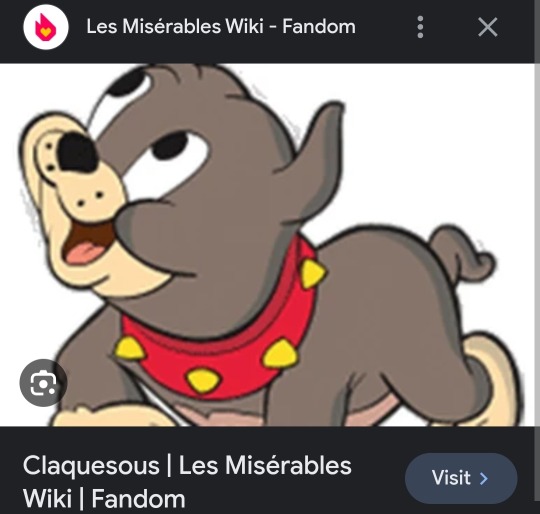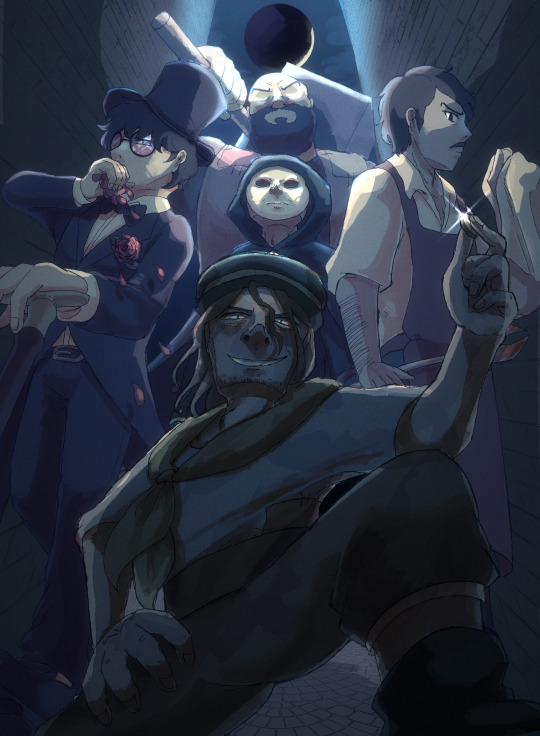#claquesous
Explore tagged Tumblr posts
Text

Some more ✨️
245 notes
·
View notes
Text


What if I said Les Mis art in 2024, what if I said Valvert?
224 notes
·
View notes
Text
LES MISERABLES INCORRECT QUOTES
(PART 4 - I love making this shit soooo much)
MONSIEUR THENARDIER

CLAQUESOUS

PATRON MINETTE+ THENARDIERS

ENJOLRAS

BOSSUET

GAVROCHE

NATIONAL GUARDS vs BARRICADE BOYS

(about) JEAN VALJEAN

GRANTAIRE

#les miserables#les mis#the brick#grantaire#enjolras#barricade boys#gavroche#claquesous#patron minette#monsieur thenardier#thenardiers#bousset#bossuet#jean valjean#les mis incorrect quotes
324 notes
·
View notes
Text

Uh.. no... no, i don't think that's right... just an inkling of a feeling, though...
#seanposting#les mis#les miserables#patron-minette#montparnasse#claquesous#thenardier#and the best tags for reach#enjolras#grantaire#combeferre#courfeyrac
487 notes
·
View notes
Text

pov: you’re getting mugged
#thenardier#montparnasse#guelemer#claquesous#babet#patron-minette#les mis#les miserables#illustration#thenardier made this illsutration harder than it needed to be for reasons that are entirely my fault#but it’s still funnier to blame him
130 notes
·
View notes
Text

more fics of enjolras beating the shit out of claquesous please 🙏
iv.xii.viii
41 notes
·
View notes
Text




The Four Heads of Patron-Minette. Volume 3, Book 7, Chapter 3.
Clips from <Il cuore di Cosette>.
#Les miserables#les mis#My Post#Patron-Minette#Gueulemer#Babet#Claquesous#Montparnasse#The Brick#Il cuore di Cosette#Les Mis Letters
28 notes
·
View notes
Text
The porter’s murder is terrifying and graphic; he couldn’t see what was happening, and Hugo tells us how the bullet passed through him. The barricade now has an element of horror that can’t be forgotten.
I shouldn’t have used the word “terrifying” for Le Cabuc’s act, because Enjolras is terrifying, too. He just forces this man down! And he kills him so calmly! This what ��capable of being terrible” really means – he’s caring to his friends and loves the people, but he’s willing to do dark things for his cause, and he’s resolute in doing so (and he even says “terrible” to describe his actions in some translations!).
When Enjolras told Grantaire to leave because he was “dishonoring” the barricade, he was operating the same way he is here. Le Cabuc sullied the barricade’s integrity with murder, so he was executed. But Enjolras condemns himself as executioner, too, because he believes violence is abhorrent (“Death, I make use of thee, but I abhor thee”). His act is just in his eyes, yes, but it’s just in an “old” order that yields to “necessity.” He wants none of that to exist! And so he thinks he must die, too, because now he is tainted by the violence of the old world. His speech is moving, but it’s tragic. The hopeful side is one he excludes himself from entirely.
Combeferre is the first to say he’ll join him, which is moving for two reasons. One (and most generally), it’s a sign of how much they care about each other. Enjolras hadn’t said what his fate would be, but Combeferre offers to share it immediately, regardless of how bad it is! Secondly, Enjolras’ view of justice here has likely been influenced by Combeferre: “the good must be innocent,” and Enjolras can’t see himself as “innocent” after what he did. Therefore, he is no longer “good,” and cannot see himself in that perfect world. And Combeferre isn’t the only influence! He says “the human race,” not “France,” suggesting that Feuilly’s broader perspective may have gotten to him. But Combeferre’s influence is the one that condemns him.
This may sound like a critique of Combeferre (that sort of life-long punishment wasn’t his intention – it resembles the prison system), but it’s also important to keep in mind that while these are beloved characters to us, they’re also symbols. To those who despised protests for being messy and violent, what could be more appealing than someone who rejects that aspect so entirely that he disciplines the barricade and condemns himself for what he’s done? It’s difficult to say the barricade is full of “troublemakers” in the face of Enjolras’ principles, and it encourages those who simply want peace to sympathize with him (a revolutionary) most of all.
And Le Cabuc was probably Claquesous! It would make sense with how he was a stranger to those who supposedly knew him, maintaining his air of mystery. And it means there really were a lot of police spies, with two known (possible) ones at just one barricade! Claquesous’ violence may have even been intentional if he was there as a spy, trying to turn the people against the barricade by making it needlessly violent.
#Les mis letters#lm 4.12.8#Enjolras#le cabuc#Claquesous#combeferre#it’s such a memorable chapter and there’s probably something to be said about the possibility of a spy causing problems intentionally#But I don’t have any coherent thoughts
119 notes
·
View notes
Text

Look upon this fine collection, crawled from underneath a stone.
#Cait Directs Les Mis#Les Miserables#Patron Minette#Patron Minette you will always be famous#Claquesous#Babet#Montparnasse#Brujon#Madame Thenardier#The Robbery#Musical Theatre#Community Theatre
20 notes
·
View notes
Text





Les Misérables, French Comic by Houy Raymond (1953)
I always feel happy when I see some adaptations that appreciate them and show them all even though I don't usually care about them so much.. but I LOVE SEEING THEM.
168 notes
·
View notes
Text


What if I said Les Mis art in 2024, what if I said Valvert.
#valvert#enjolras#jean valjean#grantaire#illustration#fanart#les miz#les mierables#les mis#montparnasse#claquesous
180 notes
·
View notes
Text


LES MIS LETTERS IN ADAPTATION - Composition of the Troupe, LM 3.7.4 (Les Miserables 1925)
Patron-Minette,—such was the name which was bestowed in the subterranean circulation on the association of these four men. In the fantastic, ancient, popular parlance, which is vanishing day by day, Patron-Minette signifies the morning, the same as entre chien et loup—between dog and wolf—signifies the evening. This appellation, Patron-Minette, was probably derived from the hour at which their work ended, the dawn being the vanishing moment for phantoms and for the separation of ruffians. These four men were known under this title. When the President of the Assizes visited Lacenaire in his prison, and questioned him concerning a misdeed which Lacenaire denied, “Who did it?” demanded the President. Lacenaire made this response, enigmatical so far as the magistrate was concerned, but clear to the police: “Perhaps it was Patron-Minette.”
#Les Mis#Les Miserables#Les Mis Letters#Les Mis Letters in Adaptation#Les Mis 1925#Les Miserables 1925#Patron-Minette#Montparnasse#Babet#Claquesous#Gueulemer#lesmisedit#lesmiserablesedit#pureanonedits#LM 3.7.4
86 notes
·
View notes
Text






















Aaaaand there they are, all of them ! Can you believe it took me more than one year to do all that, starting with the sketches !
I love them all ! but I think my favourite is probably the Jehan one.
ID texts in the alt description.
#les miserables#enjolras#jean valjean#my Drawings#javert#grantaire#courfeyrac#combeferre#feuilly#bahorel#joly#bossuet#musichetta#marius pontmercy#cosette#eponine thenardier#gavroche thenardier#monseigneur myriel#fantine#babet#montparnasse#claquesous#gueulemer#montparnasse the cat#jude the cat#mary shelley the cat#fluffy the terrible the cat#tangerine the cat#lucky the cat#orion the cat
47 notes
·
View notes
Text
EMCEE FROM "CABARET" AND CLAQUESOUS FROM "LES MIS" HAVE THE SAME VIBES. I will not elaborate.
(this is a self indulgent post, forgive me citizens)
12 notes
·
View notes
Text
This user is a Claquesous and Gueulemer apologist
#Claquesous#Gueulemer#they’re my little guys#les mis#patron minette#they’re not guilty#they did all of that#but#y’know
11 notes
·
View notes
Text


Character design of this wonderful man by @hyacinthusart
#i am so normal#so normal about him#claquesous#patron minette#frankensimpart#les mis fandom#les miserables#les mis fanart#les amis fanart#les miserables fanart#he’s trans#because we said so
25 notes
·
View notes